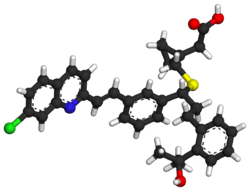Montelukast
 | |
 | |
| Clinical data | |
|---|---|
| Trade names | Singulair |
| AHFS/Drugs.com | Monograph |
| MedlinePlus | a600014 |
| Pregnancy category | |
| Routes of administration | Oral |
| ATC code | R03DC03 (WHO) |
| Legal status | |
| Legal status | |
| Pharmacokinetic data | |
| Bioavailability | 63% to 73% |
| Protein binding | 99% |
| Metabolism | Hepatic (CYP2C8-majour, CYP3A4 and CYP2C9-minor) [1] |
| Biological half-life | 2.7-5.5 hours |
| Excretion | Biliary |
| Identifiers | |
| |
| CAS Number |
158966-92-8 |
| PubChem (CID) | 5281040 |
| IUPHAR/BPS | 3340 |
| DrugBank |
DB00471 |
| ChemSpider |
4444507 |
| UNII |
MHM278SD3E |
| KEGG |
D08229 |
| ChEBI |
CHEBI:50730 |
| ChEMBL |
CHEMBL787 |
| ECHA InfoCard | 100.115.927 |
| Chemical and physical data | |
| Formula | C35H36ClNO3S |
| Molar mass | 586.184 g/mol |
| 3D model (Jmol) | Interactive image |
| |
| |
| (verify) | |
Montelukast (trade name Singulair) is a leukotriene receptor antagonist (LTRA) used for the maintenance treatment of asthma and to relieve symptoms of seasonal allergies.[2][3] Montelukast comes as a tablet, a chewable tablet, flash tablet and granules to take by mouth.[4] Montelukast is usually taken once a day with or without food.[4] Montelukast is a CysLT1 antagonist; it blocks the action of leukotriene D4 (and secondary ligands LTC4 and LTE4) on the cysteinyl leukotriene receptor CysLT1 in the lungs and bronchial tubes by binding to it. This reduces the bronchoconstriction otherwise caused by the leukotriene and results in less inflammation.
Because of its mechanism of action, it is not useful in the treatment of acute asthma attacks.
Another leukotriene receptor antagonist is zafirlukast (Accolate). Zileuton (Zyflo), an asthma drug, blocks leukotriene synthesis by inhibiting 5-lipoxygenase, an enzyme of the eicosanoid synthesis pathway.[5]
The Mont in Montelukast stands for Montreal, the place where Merck developed the drug.[6]
Medical uses
Montelukast is used for a number of conditions including asthma, exercise induced bronchospasm, allergic rhinitis, primary dysmenorrhoea (i.e. dysmenorrhoea not associated with known causes; see dysmenorrhea causes), and urticaria.[7] It is mainly used as a complementary therapy in adults in addition to inhaled corticosteroids, if they alone do not bring the desired effect. It is also used to prevent allergic reactions and asthma flare-ups during the administration of intravenous immunoglobulin.
Montelukast is administered as montelukast sodium, with 5.2 mg of montelukast sodium being equivalent to 5 mg of montelukast.[8]
Adverse effects
Side effects include gastrointestinal disturbances, headaches, and hypersensitivity reactions, in addition to other generic adverse reactions. Eosinophilia has also been documented as well as edema in post-marketing. There is no exact statement connecting the two events in the FDA label information, however it is known that the drug Valproic acid which has an adverse effect of eosinophilia is directly linked with lymphadenopathy which is known to lead to edema.
http://www.accessdata.fda.gov/drugsatfda_docs/label/2014/020829Orig1s068,020830Orig1s070,021409Orig1s045lbl.pdf http://www.accessdata.fda.gov/drugsatfda_docs/label/2016/018081s064,018082s047lbl.pdf
FDA investigation
In March 2008, the U.S. Food and Drug Administration (FDA) announced that it would investigate whether mood changes and suicidal thoughts are possible side effects of drugs in this class, including the popular drug Singulair, which currently lists these side effects.[9]
On June 12, 2009, the FDA concluded their review into the possibility of neuropsychiatric side effects with leukotriene modulator drugs. Although clinical trials only revealed an increased risk of insomnia, post-marketing surveillance showed that the drugs are associated with a possible increase in suicidal behavior and other side effects such as agitation, aggression, anxiousness, dream abnormalities and hallucinations, depression, irritability, restlessness, and tremor.[10]
Drug interactions
Montelukast, unlike many drugs, has very few drug-drug interactions. This is due to the lack of off-target affinity towards other targets in the body where it might exert an effect. However, it is important to note that montelukast is an inhibitor of the drug metabolizing enzyme CYP2C8. Therefore, it is theoretically possible that the combination of montelukast with a CYP2C8 substrate (e.g. amodiaquine, an anti-malarial drug) could increase the plasma concentrations of the substrate.[11][12]
Pharmacogenetics
Two genes of interest are ALOX5 and LCT4S.
Use with loratadine
Schering-Plough and Merck sought permission to market a combined tablet with loratadine (Claritin) and montelukast (Singulair), as many patients combine the two themselves. However, the FDA has found no benefit from a combined pill for seasonal allergies over taking the two drugs in combination,[13] and on April 25, 2008, issued a "not approvable" letter for the combination.[14]
Uses under study
Ludwig Aigner from Paracelsus Medical University in Austria presented findings at the October 2015 meeting of the Society for Neuroscience in Chicago which showed that administration of Montelukast to older rats rejuvenated their brains, returning the same functionality as that of young rats. Human trials are planned, starting with Parkinsons patients.[15] The researchers conducted the experiment with montelukast because it reduces inflammation in the lungs and they thought it might also reduce inflammation in the brain. Some research has suggested that decline in memory skills may be associated with inflammation in the brain.[16]
Dosage and administration
The usual dose of Montelukast in adults and teenagers is one 10 mg tablet taken orally a day. In children 6 to 14 years of age the usual dosage is one 5 mg chewable tablet a day.
Patents
Singulair was covered by U.S. Patent No. 5,565,473[17] which expired on August 3, 2012.[18] The same day, the FDA approved several generic versions of montelukast.[19]
The United States Patent and Trademark Office launched a reexamination of the patent covering Singulair on May 28, 2009. The decision was driven by the discovery of references that were not included in the original patent application process. The references were submitted through Article One Partners, an online research community focused on finding literature relating to existing patents. The references included a scientific article produced by a Merck employee on the active ingredient in Singulair. A previously filed patent had been submitted in the same technology area.[20] Seven months later the U.S. Patent and Trademark Office determined that the patent in question was valid based on the initial reexamination and new information provided, submitting their decision on December 17, 2009.[21]
Brand names
Montelukast is sold under a variety of brand names including Montair-10,Montelo-10, Monteflo, and Tukast L in India, Montril, Lumona, Lumenta, and Arokast in Bangladesh, Monkast in Nepal, Respicare in Pakistan, Montelair in Brazil and AirOn in Venezuela .
References
- ↑ "EMC-Montelukast 10 mg film coated tablets".
- ↑ Lipkowitz, Myron A. and Navarra, Tova (2001) The Encyclopedia of Allergies (2nd ed.) Facts on File, New York, p. 178, ISBN 0-8160-4404-X
- ↑ "Asthma / Allergy ". Mascothealth.com. Retrieved 9 April 2011.
- 1 2 Montelukast article on Medline Plus http://www.nlm.nih.gov/medlineplus/druginfo/meds/a600014.html "Montelukast comes as a tablet, a chewable tablet, and granules to take by mouth. Montelukast is usually taken once a day with or without food."
- ↑ Chen, Chao; Lv, Yan; Zhang, Hong; Wang, Gang (2014). "Does zafirlukast reduce future risk of asthma exacerbations in adults? Systematic review and meta-analysis". Multidisciplinary Respiratory Medicine. 9 (1): 30. doi:10.1186/2049-6958-9-30. ISSN 2049-6958.
- ↑ http://www.merckfrosst.ca/mfcl/en/corporate/research/accomplishments/singulair.html
- ↑ "Montelukast Sodium". The American Society of Health-System Pharmacists. Retrieved 3 April 2011.
- ↑ Soni, Rajeev; Sagar, Gali Vidya; Sharma, Pankaj (2012). "Formulation, development and in-vitro evaluation of mucoadhesive bilayered buccal patches of montelukast sodium" (PDF). International Journal of Pharmacy and Pharmaceutical Studies. 4 (2).
- ↑ FDA Investigates Merck Drug-Suicide Link
- ↑ Updated Information on Leukotriene Inhibitors: Montelukast (marketed as Singulair), Zafirlukast (marketed as Accolate), and Zileuton (marketed as Zyflo and Zyflo CR). Food and Drug Administration. Published June 12, 2009. Accessed June 13, 2009.
- ↑ Artesunate Amodiaquine Winthrop (artesunate, amodiaquine) [summary of product characteristics]. Gentilly, France: Sanofi-aventis; August 2010. http://www.wipo.int/export/sites/www/research/en/data/sanofi/marketed_products/Artesunate_and_Amodiquine.pdf
- ↑ German P, Greenhouse B, Coates C, et al. Hepatotoxicity due to a drug interaction between amodiaquine plus artesunate and efavirenz. Clin Infect Dis. 2007;44(6):889-891. PID: 17304470
- ↑ Rubenstein, Sarah (April 28, 2008). "FDA Sneezes at Claritin-Singulair Combo Pill". The Wall Street Journal.
- ↑ Schering-Plough press release - Schering-Plough/MERCK Pharmaceuticals Receives Not-Approvable Letter from FDA for Loratadine/Montelukast
- ↑ Hamzelou, Jessica (23 October 2015). "Old rat brains rejuvenated and new neurons grown by asthma drug". New Scientist. Retrieved 28 October 2015.
- ↑ Yirka, Bob. "Asthma drug found to rejuvenate older rat brains". medicalxpress.com. Retrieved 3 November 2015.
- ↑ 5,565,473
- ↑ Singular patent details
- ↑ "FDA approves first generic versions of Singulair to treat asthma, allergies". 3 August 2012. Retrieved 15 August 2012.
- ↑ "U.S. Reexamines Merck's Singulair Patent". Thompson Reuters. May 28, 2009.
- ↑ "Merck Says U.S. Agency Upholds Singulair Patent". Thompson Reuters. December 17, 2009.